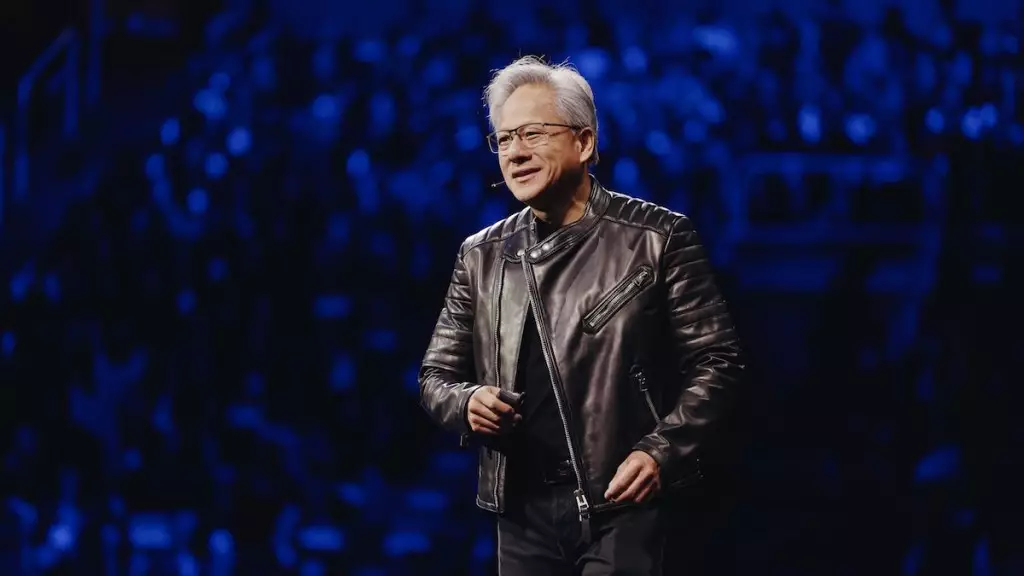The rapid evolution of artificial intelligence (AI) is showcasing an unprecedented demand for computational power that has led data centers to transform into buzzing hubs of innovation known as AI factories. At the recent GTC event, NVIDIA’s founder and CEO Jensen Huang elucidated this transformation, drawing attention to the shift from model training to production inference. This move isn’t just a technical upgrade; it’s an entire paradigm shift that signifies the beginning of a new era in AI capabilities. The forecasted market opportunity, valued at a staggering $1 trillion, underscores the urgency to elevate infrastructure that can handle these demands with unprecedented efficiency and speed.
NVIDIA’s announcements at GTC are a clarion call for industries to adapt swiftly. The introduction of the Blackwell Ultra AI platform is a game-changer that promises a remarkable 40x performance enhancement over its predecessor, Hopper. Such astonishing leaps in architecture not only redefine how AI models are trained but also enhance their deployment across services, making the use of AI more scalable and impactful. This kind of evolution is paramount as the world leans into the age of agentic and physically embodied AI, with applications poised to reach into every industry imaginable.
Pioneering New Frontiers with Blackwell and Beyond
What the Blackwell Ultra platform signifies extends beyond mere statistics; it highlights NVIDIA’s commitment to relentless progress. By 2025, this technology will provide the robust framework needed for future AI endeavors, opening the floodgates to new AI models that were previously inconceivable. With expanded memory capabilities, Blackwell Ultra aims not just for higher performance but also for superior outcomes in handling complex, data-intensive processes within AI applications.
Moreover, NVIDIA’s forward-thinking approach isn’t limited to just GPUs. The company is setting the pace for seismic shifts throughout AI infrastructure, including innovations in networking, storage, and energy efficiency. Such advancements promise to significantly reduce energy consumption within colossal AI data centers which, in an era of climate awareness, is an increasingly pivotal concern for sustainable tech development.
Expanding Horizons: AI in Robotics and Industry
The implications of NVIDIA’s advancements stretch far beyond enhanced computing power. Huang painted a picture of the burgeoning physical AI market valued at around $50 trillion, an opportunity to transform sectors like manufacturing, healthcare, and logistics through AI-driven automation. NVIDIA’s pioneering Isaac and Cosmos platforms exemplify the company’s leadership in the robotics field, propelling the next generation of intelligent machines that can integrate seamlessly into various workflows and logistics chains.
In light of these changes, organizations must realize that the potential for robotics is limitless when combined with cutting-edge AI technologies. Machines powered by advanced AI can replicate human reasoning and skills with astonishing accuracy, an achievement that will undoubtedly reshape the landscape of work itself and may ultimately redefine traditional employment structures.
Building the Future with Integrated Technologies
NVIDIA’s roadmap outlines an impressive array of innovations set to arrive in the coming years, demonstrating that the company recognizes the need for persistent evolution in a fast-paced technological environment. With the introduction of new architectures like Vera Rubin and Feynman, NVIDIA is not just keeping up but aggressively setting the standard for what AI infrastructure should look like in the upcoming decade.
Critical to this development is the emphasis on effective networking infrastructures, like Spectrum-X and Quantum-X, both designed to interconnect vast arrays of GPUs across different sites while conserving energy. The collaboration of companies such as ASUS, Dell, and HP to develop the DGX personal AI computers illustrates a broad recognition of the potential to create specialized, powerful AI solutions available at the desktop level. This accessibility will lower barriers to entry for smaller organizations striving to benefit from AI.
Innovations in Thought: Customization and Collaboration
The open-source Dynamo software offers further insights into how collaboration can streamline AI advancements. By enhancing multi-step reasoning processes, it signifies a collective move toward boosting innovation timelines, speeding up the rate of breakthroughs in AI technology. This spirit of collaboration extends to NVIDIA’s partnership with Google DeepMind and Disney Research for the development of the Newton physics engine, which aims to teach robots how to navigate complex tasks with higher precision.
As such, NVIDIA is not merely a player in the AI landscape; it is setting the stage for a symphony of advancements that promise to harmonize AI and robotics into every sector. The emergence of foundational models like the HUMANOID GR00T N1 demonstrates the significant strides made toward incorporating nuanced cognitive functions within robotic systems, forging new partnerships between humans and machines.
The landscape of AI is indeed evolving at breakneck speed, and NVIDIA stands at the forefront, ready to not just participate but lead this riveting journey into an extraordinarily intelligent future.

